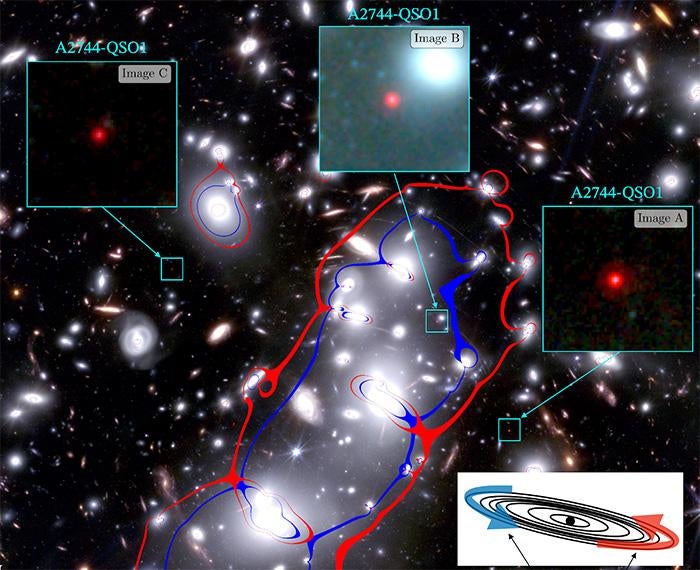
Subscribe to Pittwire Today
Get the most interesting and important stories from the University of Pittsburgh.Rachel Bezanson was on a team of astronomers that detected a black hole in the early universe

Analyzing images from the James Webb Space Telescope (JWST), astronomers have detected an extremely red, gravitationally lensed supermassive black hole in the early Universe. Its colors suggest the black hole lies behind a thick veil of dust obscuring much of its light.
The team used images from the UNCOVER program, co-led by Rachel Bezanson, associate professor of physics and astronomy in the Kenneth P. Dietrich School of Arts and Sciences, and Ivo Labbé, from Swinburne University of Technology in Australia. They managed to measure the black hole mass and discovered it was significantly more massive compared to its host galaxy than what has been seen in more local examples.
The finding was published Feb. 14 in the journal Nature.
"Analysis of the object's colors indicated that it was not a typical star-forming galaxy," Bezanson said. "Together with its compact size, it became evident this was likely a supermassive black hole, although it was still different from other quasars found at those early times." The discovery of the uniquely red and compact object was published last year in the Astrophysical Journal.
Integral to the finding was the effect of gravitational lensing, a phenomenon whereby an object or objects — in this case, a cluster of galaxies — are so massive, it curves the space around it. Light from behind the galaxy cluster observed by JWST followed that curved space and astronomers were able to see objects that would otherwise be hidden behind the cluster. The light was also magnified, allowing astronomers to observe even more distant objects than ever before.
Using that magnified light, researchers observed something special.
The black hole turned out to be more than supermassive — its mass was unusually high compared to the galaxy it was in. This could present a clue to the question of which came first, the black hole or the galaxy. This research will help further astronomers’ understanding of the origins and effects of black holes in the early universe.
For example, astronomers do not know if such supermassive black holes grow from stellar remnants, or perhaps from material that directly collapsed into black holes in the early Universe.
"In a way, it's the astrophysical equivalent of the chicken and egg problem," said Adi Zitrin, professor at Ben-Gurion University of the Negev and co-lead on this study. “We do not currently know which came first — the galaxy or black hole, how massive the first black holes were and how they grew."
— Brandie Jefferson, written in collaboration with Ben-Gurion University of the Negev; figure courtesy of Lukas Furtak, Adi Zitrin, Ivo Labbé, Rachel Bezanson and the UNCOVER team, NASA/ESA/CSA JWST. The composite-color image shows the galaxy cluster Abell 2744. The blue and red contours indicate areas of most extreme gravitational lensing predicted by the team's lens model of the cluster. The three lensed images of the distant reddened black hole, A2744-QSO1, are highlighted. This object is the most distant gravitationally lensed black hole observed to date.

